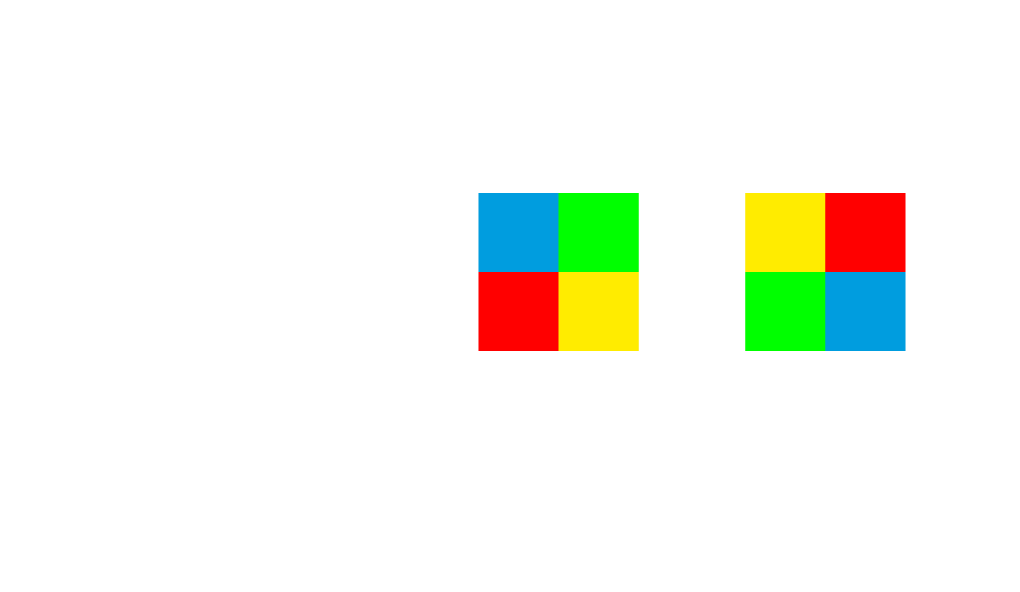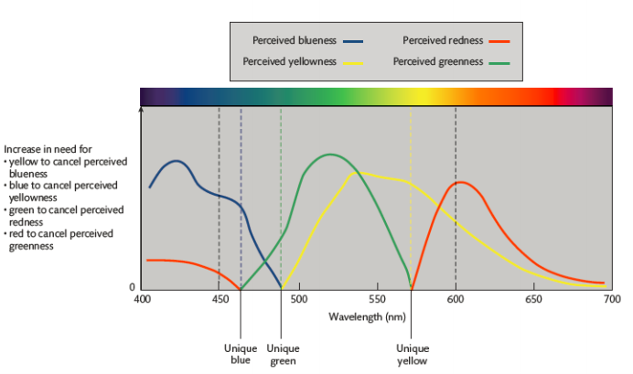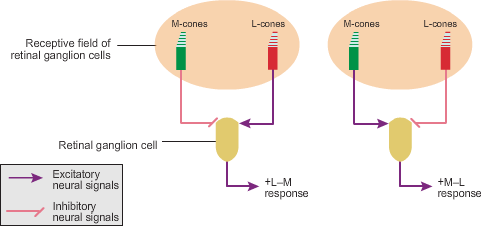Chapter 5. Opponent Color Representation
5.1 Title slide

Opponent Color
Representation
Explore how hue cancellation experiments reveal the perceived amounts of red, green, blue, and yellow in monochromatic light; interact with the retinal circuits that underlie these perceptions.
CLICK ANYWHERE TO BEGIN
blank white surface, you’ll see an afterimage that looks something like the image on the right.
Opponent color representation accounts for the way in which the visual system processes the pairs
of complementary colors red–green and blue–yellow.
What Is Opponent Color Representation?
In some respects, the human visual system operates as if there were four basic colors divided into two pairs of complementary colors, with the members of each pair being in some sense opposites: red–green and blue–yellow. Hue cancellation experiments test this idea. A person is shown a monochromatic test light and instructed to neutralize, or cancel out, a perceived basic color in the light by adding its complement.
As shown in Figure 1, the results of such experiments indicate that, except for three "unique" wavelengths, all the wavelengths in the visible spectrum are perceived as containing some redness or greenness and some blueness or yellowness:
• From about 400 nm to about 489 nm (unique green), lights are perceived as having blueness but no yellowness.
• Above the unique-green wavelength, lights appear to have yellowness but no blueness.
• From about 464 nm (unique blue) to about 572 nm (unique yellow), lights are perceived as having greenness but no redness.
• Above unique yellow and below unique blue, lights are perceived as having redness but no greenness.
• The unique wavelengths aren’t perceived as combinations, but as purely blue, green, or yellow (unique blue and unique yellow are perceived as having no redness and no greenness; unique green is perceived as having no blueness and no yellowness). There is no unique red because, even though the longest wavelengths all look red, they are still perceived as having some yellowness.
Four different types of color-opponent retinal circuits are thought to underlie these perceptions:

Figure 1
• In a +L–M circuit, the RGC receives excitatory signals from L-cones and inhibitory signals from M-cones. The RGC fires above its baseline rate in response to long-wavelength light and below its baseline rate in response to medium-wavelength light.
• In a +M–L circuit, the RGC receives excitatory signals from M-cones and inhibitory signals from L-cones. The RGC fires above its baseline rate in response to medium-wavelength light and below its baseline rate in response to long-wavelength light.
• In a +S–ML circuit, the RGC receives excitatory signals from S-cones and inhibitory signals from M-cones and L-cones. The RGC fires above its baseline rate in response to short-wavelength light and below its baseline rate in response to medium- and long-wavelength light.
• In a +ML–S circuit, the RGC receives excitatory signals from M-cones and L-cones and inhibitory signals from S-cones. The RGC fires above its baseline rate in response to medium- and long-wavelength light and below its baseline rate in response to short-wavelength light.
Thus, +S–ML and +ML–S neurons respond oppositely to blue and yellow light, so their outputs support the perception of blue and yellow as basic and opposite colors. And similarly, +L–M and +M–L neurons respond oppositely to green and red light, so their outputs support the perception of green and red as basic and opposite colors.
5.2 Explain - dnd
The graphs in this demonstration show the results of hue cancellation experiments. Participants are presented with monochromatic light and must add a complementary color in order to cancel out a perceived hue. For example, if a light is presented that's perceived as containing a certain amount of blueness, the participant adds yellow light (the complement of blue) until no more blueness is perceived. The amount of added yellow light is a measure of how much blueness was perceived in the original light. In this demonstration, you'll explore these results separately for blue vs. yellow and for red vs. green.
Perceived Blueness vs. Perceived Yellowness
With the exception of "unique green" (typically, about 489 nm), wavelengths across the visible spectrum are perceived as containing some amount of either blue or yellow but not both. Drag the slider to change the wavelength of the presented light. You'll see how the perceived amount of blue or yellow depends on wavelength.
5.3 Explain - dnd
Perceived Redness vs. Perceived Greenness
With the exception of "unique blue" (typically, about 464 nm) and "unique yellow" (typically, about 572 nm), wavelengths across the visible spectrum are perceived as containing some amount of either red or green but not both. Note that both the longer wavelengths (above "unique yellow") and the shorter wavelengths (below "unique blue") are perceived as containing some redness. Drag the slider to change the wavelength of the presented light. You'll see how the perceived amount of red or green depends on wavelength.
5.4 Explain - dnd
Considering Blue–Yellow and Red–Green Information Together
If you drag the slider, you can see that knowing only the amount of perceived blueness or yellowness in a light wouldn't let you determine the wavelength (e.g., a 512-nm light contains about the same amount of perceived yellowness as a 600-nm light), nor would knowing only the amount of perceived redness or greenness (e.g., a 600-nm light contains about the same amount of perceived redness as a 614-nm light).
But knowing both the perceived amount of blueness or yellowness and the perceived amount of redness or greenness does let you determine the wavelength. Drag the slider and note how each wavelength produces a unique pattern in the graphs on the right.
5.5 Explain - dnd
Blue–Yellow Opponent Circuits (+S–ML and +ML–S)
Important note: On previous screens, the bar graphs showed how the perception of opponent colors varied with the wavelength of light. On this screen and the next, the bar graphs show how the responses of the retinal ganglion cells (RCGs) in the color-opponent neural circuits underlying those perceptions vary with wavelength.
Drag the slider to see how the firing rates of the retinal ganglion cells (RGCs) in these two different types of blue–yellow color-opponent circuits vary in response to different wavelengths of light:
In response to short wavelengths, the RGC in a +S–ML circuit fires above baseline and the RGC in a +ML–S circuit fires below baseline.
In response to medium and long wavelengths, the RGC in a +S–ML circuit fires below baseline and the RGC in a +ML–S circuit fires above baseline.
Click WHAT'S GOING ON? to see why.
In a +S–ML circuit, the signals from S-cones are excitatory and the signals from M-cones and L-cones are inhibitory. The RGC in this type of circuit fires above its baseline rate in response to short-wavelength light and below its baseline rate in response to medium- and long-wavelength light.
In a +ML–S circuit, the signals from M-cones and L-cones are excitatory and the signals from S-cones are inhibitory. The RGC in this type of circuit fires above its baseline rate in response to medium- and long-wavelength light and below its baseline rate in response to short-wavelength light.

5.6 Explain - dnd
Red–Green Opponent Circuits (+L–M and +M–L)
Drag the slider to see how the firing rates of the retinal ganglion cells (RGCs) in these two different types of red–green color-opponent circuits vary in response to different wavelengths of light:
In response to long wavelengths, the RGC in a +L–M circuit fires above baseline and the RGC in a +M–L circuit fires below baseline.
In response to medium wavelengths, the RGC in a +L–M circuit fires below baseline and the RGC in a +M–L circuit fires above baseline.
Click WHAT'S GOING ON? to see why.
In a +L–M circuit, the signals from L-cones are excitatory and the signals from M-cones are inhibitory. The RGC in this type of circuit fires above its baseline rate in response to long-wavelength light and below its baseline rate in response to medium-wavelength light.
In a +M–L circuit, the signals from M-cones are excitatory and the signals from L-cones are inhibitory. The RGC in this type of circuit fires above its baseline rate in response to medium-wavelength light and below its baseline rate in response to long-wavelength light.

5.7 Explain
What Is Opponent Color Representation?
In some respects, the human visual system operates as if there were four basic colors divided into two pairs of complementary colors, with the members of each pair being in some sense opposites: red–green and blue–yellow. Hue cancellation experiments test this idea. A person is shown a monochromatic test light and instructed to neutralize, or cancel out, a perceived basic color in the light by adding its complement.
As shown in the figure, the results of such experiments indicate that, except for three "unique" wavelengths, all the wavelengths in the visible spectrum are perceived as containing some redness or greenness and some blueness or yellowness:
• From about 400 nm to about 489 nm (unique green), lights are perceived as having blueness but no yellowness.
• Above the unique-green wavelength, lights appear to have yellowness but no blueness.
• From about 464 nm (unique blue) to about 572 nm (unique yellow), lights are perceived as having greenness but no redness.
• Above unique yellow and below unique blue, lights are perceived as having redness but no greenness.
• The unique wavelengths aren’t perceived as combinations, but as purely blue, green, or yellow (unique blue and unique yellow are perceived as having no redness and no greenness; unique green is perceived as having no blueness and no yellowness). There is no unique red because, even though the longest wavelengths all look red, they are still perceived as having some yellowness.
Four different types of color-opponent retinal circuits are thought to underlie these perceptions:
• In a +L–M circuit, the RGC receives excitatory signals from L-cones and inhibitory signals from M-cones. The RGC fires above its baseline rate in response to long-wavelength light and below its baseline rate in response to medium-wavelength light.
• In a +M–L circuit, the RGC receives excitatory signals from M-cones and inhibitory signals from L-cones. The RGC fires above its baseline rate in response to medium-wavelength light and below its baseline rate in response to long-wavelength light.
• In a +S–ML circuit, the RGC receives excitatory signals from S-cones and inhibitory signals from M-cones and L-cones. The RGC fires above its baseline rate in response to short-wavelength light and below its baseline rate in response to medium- and long-wavelength light.
• In a +ML–S circuit, the RGC receives excitatory signals from M-cones and L-cones and inhibitory signals from S-cones. The RGC fires above its baseline rate in response to medium- and long-wavelength light and below its baseline rate in response to short-wavelength light.
Thus, +S–ML and +ML–S neurons respond oppositely to blue and yellow light, so their outputs support the perception of blue and yellow as basic and opposite colors. And similarly, +L–M and +M–L neurons respond oppositely to green and red light, so their outputs support the perception of green and red as basic and opposite colors.

5.8 Test - single choice
Select your answer to the question below. Then click SUBMIT.
Which of the following observations is accounted for by opponent color representation?
The correct answer is C.
Click EXPLAIN if you want to review this topic.
5.9 Test - single choice
Select your answer to the question below. Then click SUBMIT.
Why is a wavelength of about 489 nm referred to as "unique green"?
5.10 Test - single choice
Select your answer to the question below. Then click SUBMIT.
In response to which "unique" wavelength(s) of light would the RGCs in +S–ML and +ML–S circuits tend to fire at baseline?
5.11 Activity completed
Opponent Color Representation.